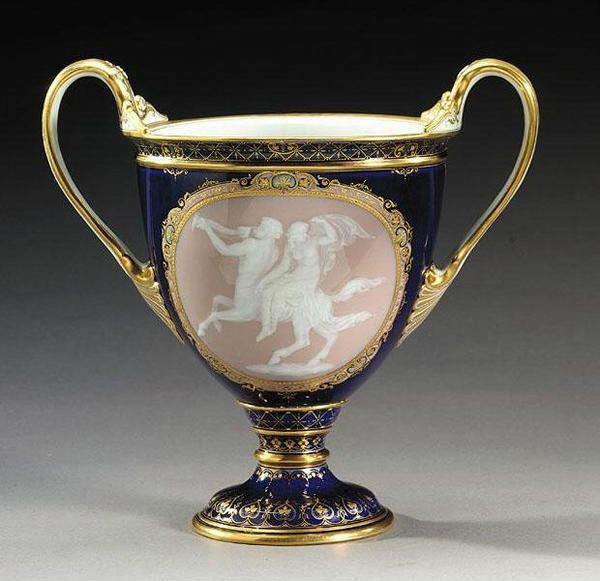It was painted in Urbino
這只碗在烏爾比諾進行彩繪
and lustred in Cupio and dated 1528
在邱比奧上釉 可追隨到1528年
It shows Mary Magdalene
上面描繪的是瑪麗·馬格達蓮
drying Christ's feet with her hair
她正在用自己的頭發為克萊斯特擦腳
The arms in the grotesque border record the marriage in 1506 of
這個圖像邊緣處的臂章記錄了1506年
Pope Julius II's illegitimate daughter Felice della Rovere
尤利烏斯二世的私生女費列西亞·德·羅維萊
to Gian Giordano Orsini, Lord Bracciano, who died in 1517
和勛爵布列琦亞羅的聯姻 后者于1517年逝世

Felice used these arms as a widow
守寡后 費列西亞
until her death in 1536
一直使用這些臂章直至1536年去世
and the beautiful plate may have been a present in her widowhood
而這只精美的盤子可能是她守寡期間
from her cousin in Urbino
由那位家住烏爾比諾的表兄
Francesco Maria I della Rovere,
弗蘭西斯卡·德·羅維萊亞所贈
Sets of maiolica dining ware seem to have been conceived as
整套的馬爵利卡陶餐具似乎被認為是
appropriate presents for noble widows in the 1520s
16世紀20年代適合饋贈給貴族寡婦的禮物
as in the case of the marvelous
就像1524到1525年間
set made by Nicola da Urbino in 1524-5
由尼科拉·德·烏爾比諾為曼基亞侯爵夫人
for Isabella d'Este
伊薩貝拉·德斯特所委托制造的
Marquess of Manchia
那一套精美絕倫的餐具
When Isabella's daughter Eleonora della Rovere
當時伊薩貝拉的女兒
duchess of Urbino
也就是烏爾比諾的公爵夫人
commissioned this set
艾拉諾拉·德·羅維萊訂做了這一套瓷器
as a present for her mother
作為贈給母親的禮物
she explained that it was suitable for life
她解釋道 這一套瓷器很適合
in the feminine literary world for her mother's villa
在她母親的莊園中營造的女性文學世界的生活
Writing to her mother in November 1524
在1524年寫給母親的信中
Eleonora explained
艾拉諾拉這樣解釋道
"I have had made a set of dining wares and urban ware
我已經訂做了一套餐具 都市化陶器
since the master craftsmen here in Urbino
因為烏爾比諾的
have some reputation for good work
工匠師傅的作品頗負盛名
and if it pleases your excellency
如果這套瓷器能夠讓母親大人高興
I shall be happy
我將非常開心
and you might make use of it in your villa in Porto
您可以在波爾圖的莊園中使用
since it's a villa thing"
因為這是符合莊園風格的瓷器
I showed you one piece from this set
我剛才向你們展示過這套
from the British Museum
來自大英博物館的瓷器中的一件
which illustrates the Justice of Trajan
它描繪了圖拉真法官的故事
a story that would have been
這個故事
considered appropriate as a tribute to Isabella
被認為是他向伊薩貝拉贈送的合適禮物
since it deals with a virtuous ruler
因為它講述的是有關一個德高望重的統治者
as well as featuring a widow as heroine
以及將一個寡婦奉為女英雄的事跡
There's a fascinating though earlier reference
在早期時候
to such maiolica wares
有一個有關這種馬爵利卡陶器皿的有趣想法
being thought suitable for a widow
被認為很適合寡婦
at least in some circles
至少在某些社會圈子是這樣
A letter of 1501 describes
1501年的一封信件
how the widowed Lucrezia Borgia was
敘述了寡婦盧克麗霞·波吉亞
abandoning her mourning for her husband
如何擺脫喪夫之痛的故事
up to now, Donna Lucrezia, according to Spanish usage
到目前為止 根據西班牙說法 盧克麗霞女士
has eaten from urban-ware maiolica
已經用都市化陶器馬爵利卡陶餐具進食
but now she's begun to eat from silver
但現在她開始使用銀器
as if almost no longer a widow
就好像她不再是寡婦一樣
From pieces commemorating specific marriages
通過其臂章推斷出
through their arms
用來紀念某個特殊婚禮的器件
we move to pieces which are painted with
現在我們轉到
inscriptions or motifs associated with marriage
繪有與婚禮相關的題字和主題
The feature of the clasped hands
這個中央有雙手緊握狀圖案的盤子
at the centre of this plate, made in
被認為是1490到1510年間在法恩扎制造的
Faenza around 1490-1510 is known as the fede motif
被認為是有關忠貞的主題
and is often found
通常在馬爵利卡陶瓷盤子 碗和瓷磚中
on maiolica dishes, bowls and tiles
可以看到
Sometimes associated with the word "fede" or faith
有時和忠貞這個詞連接在一起
It was used to denote a contract and during the middle ages
其目的是用來指代一種契約 在中世紀時期
came to serve as a symbol of betrothal or devotion
則作為訂親和忠誠的象征
The concept of faithful love
忠貞愛情的觀念
is elaborated on in related mottos
在15世紀后期的佛羅倫薩版畫中的
in late 15th century
相關愛情緘言中
Florentine engravings
得到了詳盡的闡述
like this one
就像這個這樣
showing a reclining nymph
畫面顯示的是一位臥著的少女
accompanied by the legend
旁邊有一行文字
"Love needs faith
愛情需要忠貞
and where there is no faith there can be no love"
沒有忠貞就沒有愛情











